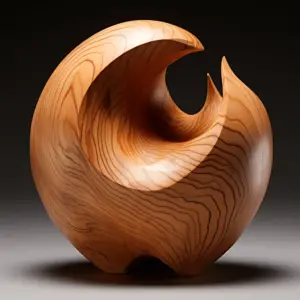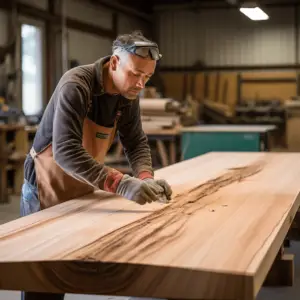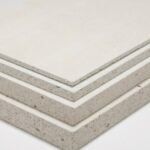There are currently two sides to the woodworking world, the side for earlywood and the side for latewood.
So, what is the difference between latewood and earlywood? This article aims to help shed some light on this subject to help you choose the right wood for your project.
Table of Contents
What is Earlywood?

Earlywood is the wood produced early in the tree’s growing season. The earlywood part of a growth ring is often called springwood because it was formed during the spring months. This wood is generally lighter in color, less dense, and more porous than latewood.
Earlywood develops at the start of the growing season when the cells are large, thin-walled, and numerous. This early development produces soft, less dense, and more porous wood with large, easily visible pores. This type of springwood allows for a high water flow rate to the tree’s leaves.
What can you make with earlywood?
Using the right wood for your project can make all the difference.
If you select boards and build with lumber that has an equal proportion of early- and latewood, your furniture will be strong and durable. But if you want to build furniture that requires bending or steam-bending, it’s best to use lumber with a high percentage of earlywood.
How fast does earlywood grow?
Earlywood grows faster than latewood. The difference in growth rate is so great that earlywood vessels are much larger and more numerous than latewood vessels. This is what gives the rings their distinctive appearance.
What is Latewood?
Latewood is the dense, hard, dark-colored wood produced by coniferous trees in late summer. It is the second growth of the year, after early spring and before the dormant season.
Latewood is derived from an adaptation of coniferous trees to withstand harsh climates. Latewood helps trees survive cold winters and dry summers by making them more resistant to high temperatures and drought conditions.
The cells formed in late summer are smaller than those formed in early spring because there is less sap (and thus less water) available to the tree during this period. The result is that latewood has a greater proportion of cell wall material per cell volume than springwood. The greater density of latewood causes it to behave differently from springwood when both are steamed for bending purposes.
Why is latewood dark?
Latewood is darker because the wood formed during this period contains a lot of lignin. The earlier wood tends to be lighter in color because it contains more cellulose and less lignin.
What can you make with latewood?
The wood is very durable because of its high density and strong structure. It is used for making furniture and flooring.
Wood from Norway spruce is widely used for construction, paper pulp, and small items.
Latewood is also a source of many products, such as fuelwood and charcoal (from the trunk), and gum (from the bark).
Pine nuts are edible but not very tasty. They are used to make oil.
Earlywood vs Latewood: What is the Difference?
Here are a few keys that can tell you the difference between softwood and hardwood.
Annual growth rings
Trees that have visible annual growth rings are hardwoods. The annual growth rings are made up of layers of earlywood and latewood, which differ in color and density. The early wood usually appears lighter in color than the latewood, which develops gradually into a darker shade throughout the summer months.
Vessels
Vessels are the pores found in the xylem tissue of trees, and they are used to convey water throughout the tree. Hardwoods contain vessels that help conduct water and other nutrients from the roots to all areas of the tree. Softwoods do not contain vessels and instead rely on tracheids, which are elongated cells with tapered ends, to transport water and nutrients within the tree.
Leaves
Hardwoods have broad leaves, which fall off in autumn or when they dry out during drought conditions. Softwoods have needles or scale-like leaves that remain attached to branches for many years until new needles push them off.
Is there a way to distinguish between the two wood types?
Yes! You can differentiate by doing a simple water test. Put a drop of water on the wood. If it soaks into the surface quickly, it’s earlywood. If not, it’s latewood.
You’ll often find that your saw cuts reveal the difference between the two types of wood in a board. The latewood (dark) cuts will be harder to push through with your saw and may even require two passes instead of one. Earlywood (light) cuts will be easier to push through with your saw.
When looking at a tree, how do you tell if it’s softwood or hardwood?

All softwoods are evergreen trees that produce cones and needle-like leaves. They tend to be fast-growing but less dense than hardwoods, making them useful for paper and pulp.
Most hardwoods are deciduous trees (meaning they lose their leaves every year). They tend to be slower growing, denser, and more expensive than softwoods.
However, there are some exceptions, such as yew (a softwood) and larch (a hardwood). These exceptions occur because the terms refer to the type of wood produced by the tree, not the type of tree itself.
One way to determine if a tree is a conifer (softwood) or an angiosperm (hardwood) is by examining its bark. The bark of most conifers has long vertical ridges with narrow furrows between them, while the bark of most angiosperms has wide flat ridges with deep furrows between them.
Is latewood stronger than earlywood?
The answer is: it depends. The strength of a piece of wood depends on the species, the grain orientation, and the presence and types of defects, such as knots and splits. The direction of loading (compression vs. tension) also affects the strength. In general, compression strength is about twice that of tension for a given species.
But there is one aspect to this question that can be answered: Earlywood tends to be less strong than latewood because earlywood cells are larger and have thinner cell walls. But the growth rate controls how much latewood is present in a log or board.
Faster growth produces more latewood, and slower growth produces more earlywood. So when comparing two pieces of wood from the same species grown in different environments, it’s not possible to say which one will be stronger without doing some tests.


